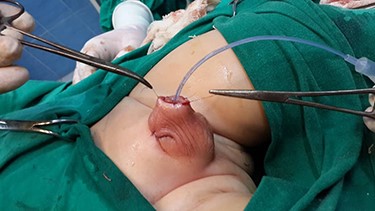-
PDF
- Split View
-
Views
-
Cite
Cite
Ragheb Assaf, Tamim Albahhah, Kusay Ayoub, Zaher Al-janzir, Mario Tarzi, Ahmad Rami Rahmeh, Ibrahim Al-Hadid, Penile reconstruction using scrotal flap after usage of monopolar electrocautery in a 2-month-old Syrian child: a case report, Journal of Surgical Case Reports, Volume 2019, Issue 12, December 2019, rjz351, https://doi.org/10.1093/jscr/rjz351
Close - Share Icon Share
Abstract
Circumcision is regarded as one of the most common procedures in pediatrics. We present a case of a newborn, who has undergone circumcision using monopolar electrocautery. He admitted to the hospital with glans necrosis and was treated with antibiotics and surgical debridement. Four months later, phalloplasty was performed for the newborn using scrotal flap. The result is satisfactory, and the penis is esthetically acceptable with effective urination. Our case suggests the use of scrotal flap for penile reconstruction due to feasibility of procedure and anatomic privilege. It would also support usage of bipolar electrocautery for circumcision to avoid possible unwanted complications of monopolar electrocautery.
INTRODUCTION
Surgical indications of circumcision are mainly divided in two groups: therapeutic and nontherapeutic, but its usage remains controversial as The American Academy of Pediatrics found that the health benefits of newborn male circumcision outweigh the risks, still the benefits are not great enough for the academy to recommend universal newborn circumcision [1].
However, that does not apply to what Moris et al. [2] have found in their study, which came up with the result that benefits exceed risks by at least 100:1.
Complications of circumcision are most commonly related to bleeding and infection [3].
Post-circumcision complications can be divided into five main categories according to the degree of penile injury and the possibility for surgical reversibility [4].
Bipolar electrocautery has been shown to be safe in circumcision [5].
However, the use of a monopolar electrocautery results in a dramatic accident. Indeed, when a monopolar electrode is used, the electrical current is carried by the small diameter of the penis, which may lead to tissue heating and thus thermal injury [6].
We present the case of a newborn who has undergone circumcision using a monopolar electrocautery device, eventually developed signs of glans gangrene Figs 1-2 leading to total loss of the glans (Grade 3). Phalloplasty was performed, and the cosmetic outlook is well appreciated.
CASE REPORT
A newborn was admitted at our hospital on day 8 smitten with signs of glans gangrene Figs 1-2 due to circumcision 2 days before admission (day 6). Initial assessment depicted normal states of temperature, blood pressure and pulse. He was treated with antibiotics and surgical debridement of dead tissues. One week following circumcision, glans has fallen, yet micturition was still accessible through urethral opening.
Two months later, the urethral opening got constricted, and many consecutive operations in order to preserve the opening were made. Catheter was placed for 10 days.
By the age of 4 months, releasing of urinary opening with spongy body and the two cavernous bodies till root of the penis was done followed by a surgical incision on the midline of the scrotum 2 cm from the urethral opening, which is meant to serve later as the length of the penile shaft; penis was pulled into the scrotum, and dermal edge attached to the urethral opening was anastomosed with the cut through scrotum Figs 3-4; finally, the upper cut close to the penis was sutured, and a catheter was placed for 2 weeks.

Glans gangrene of the infant due to circumcision using monopolar electrocautery.

Drop of the necrotic glans. Note the accessibility of the urethral opening.

Scrotal flap is used to cover the urethral opening, spongy body and cavernous bodies, which will later form the shaft of the penis.

Surgical incision was made 2 cm away from the urethral opening, and a suture was later performed on the midline.

The final shape of the Penis. It is esthetically appreciated and functional.
Patient was observed for 6 months, and no constriction or infection has happened.
By the age of 11 months, detachment of the scrotal flap around the penis was made, and a catheter was placed for 1 week.
A month later, patient depicted good status with acceptable penile shape and normal urinary opening Fig. 5.
DISCUSSION
Phalloplasty, reconstruction of the penis, is a complex endeavor that continued to evolve over the past decades, yet it remains a challenge for the constructive surgeon to maintain a favorable state of the penis esthetically, functionally and anatomically.
How phalloplasty is considered to be ideal is what Gilbert has organized in five main points:
(i) A microsurgical procedure that takes place in one stage and is reproducible.
(ii) Construction of a neo-urethra that facilitates voiding while the patient is standing.
(iii) A phallus with erogenous and tactile sensibility.
(iv) Sufficient bulk to permit prosthetic stiffener placement in order to make sexual intercourse possible.
(v) An esthetic result the patient finds satisfactory [7].
Unfortunately, we cannot apply all the previous criteria on our patient due to inability of assessment. However, the reconstructed penis is functional as the patient has an effective urination, and the result was pleasant for the patient’s parents.
There are mainly three decisions that can be made in serious penile injuries:
(i) Sex reassignment.
(ii) Phallic reconstruction using flaps, as radial forearm free flap (RAFF) being proposed as the gold standard [8].
(iii) Release of the subcutaneous corporal remnants, which is discussed in our case.
Release of the subcutaneous corporal remnants, the one discussed in our case, is done on two steps:
First, lengthening of the penile stump through release of the suspensory ligament and then burying it in the scrotal tunnel ‘tube within a tube’ for length gaining and providing a vascularized skin graft efficient enough to be detached later.
Many methods are used in mobilization of the corpora: one of which is mobilizing them up to their insertion on the pubic bone, another one would be detachment of the crura from their bony connection, either partially or totally. Neither of these methods was used in our case, as length gained by our procedure was enough for an infant.
The second step would be making a cut in between the penis and the scrotum with regards to the cylindrical shape of the penile shaft, later the skin surrounding the penis gets sutured on the midline on ventral surface, and the skin of the scrotum is sutured transversely as both sutures depicted a perpendicular pattern and the vertical suture meeting the horizontal suture in between.
In conclusion, monopolar electrocautery should be contraindicated in penile surgery and should be replaced with bipolar electrocautery. We suggest usage of scrotal flaps due to feasibility of procedure and anatomic privilege, proven by the final shape of the reconstructed penis. Psychological effect should be sought in this type of procedures, and early operation is recommended.
ACKNOWLEDGEMENTS
None.
Conflict of Interest statement
No conflicts of interest.
Funding
No funding was received for the work involved in this article.
Ethical Approval
No ethics approval is required.
Consent
Patient consent was obtained for the publication of this case report.



